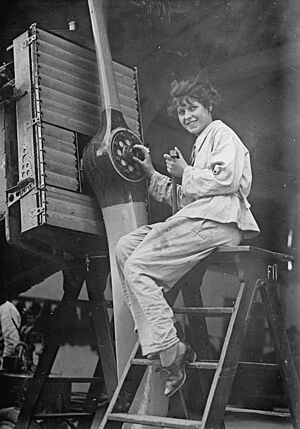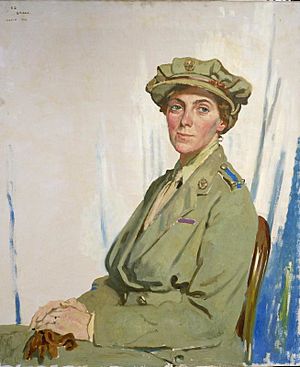Women's Royal Air Force facts for kids
Quick facts for kids Women's Royal Air Force |
|
|---|---|

25th July 1919: King's Open Court, Buckingham Palace tribute to WW I Workers. – shown: members of the Women's Royal Air Force.
|
|
| Active | 1918–1920 1949–1994 |
| Allegiance | |
| Branch | Royal Air Force |
| Role | Support services |
| Size | Peak of ~25,000 (1918–1920) |
| Garrison/HQ | RAF Hawkinge |
| Commanders | |
| Last Director WRAF | Air Commodore Ruth Montague |
| Air Chief Commandant | Princess Alice, Duchess of Gloucester |
The Women's Royal Air Force (WRAF) was a special part of the Royal Air Force (RAF) for women. It existed at two different times in history. First, it was active from 1918 to 1920, during and just after World War I. Then, it was brought back from 1949 until 1994.
The WRAF was restarted on February 1, 1949. It took over from another group called the Women's Auxiliary Air Force (WAAF), which had started in 1939 during World War II. Over the years, the WRAF and the main RAF worked more and more closely together. More types of jobs became open to women. Finally, in 1994, the WRAF officially joined with the RAF. This meant women became a full part of the British armed forces.
The Central Band of the WRAF was a special music group. It was one of only two all-female bands in the British Armed Forces. This band was closed down in 1972. Some of its musicians then moved to play in the Band of the Women's Royal Army Corps.
How Many Members?
The WRAF aimed to have about 90,000 members at one point. However, accurate numbers are hard to find until August 1, 1918. At that time, there were 15,433 members. About 5,000 were new recruits. The other 10,000 had moved from older women's groups. The WRAF never had more than 25,000 members during its first period.
Training Places
Special training centers, called depots, were opened in 1918. These were located at Handsworth College, in Glasgow, at RAF Flowerdown, RAF Spitalgate, and in York.
Later, in the 1950s, new WRAF training centers opened. These included the WRAF Depot and the WRAF Officer Cadet Training Unit. Both were located at RAF Hawkinge in Kent. These places helped train new WRAF members and future leaders.
WRAF Leaders
The WRAF had important leaders who guided the organization. These leaders helped shape the roles and training for women in the Royal Air Force.
Early WRAF Leaders (1918–1920)
During its first period, the WRAF was led by people called Commandants.
- Gertrude Crawford, 1918
- Violet Douglas-Pennant, May–September 1918
- Helen Gwynne-Vaughan, September 1918 – 1920
Later WRAF Leaders (1949–1994)
When the WRAF was restarted, its leaders were called Directors.
- Air Commandant Dame Felicity Hanbury, 1949–1950
- Air Commandant Dame Nancy Salmon, 1950–1956
- Air Commandant Dame Henrietta Barnett, 1956–1959
- Air Commandant Dame Anne Stephens, 1959–1962
- Air Commandant Dame Jean Conan Doyle, 1962–1966
- Air Commodore Dame Felicity Hill, 1966–1969
- Air Commodore Philippa Marshall, 1969–1973
- Air Commodore Molly Allott, 1973–1976
- Air Commodore Joy Tamblin, 1976–1980
- Air Commodore Helen Renton, 1980–1986
- Air Commodore Shirley Jones, 1986–1989
- Air Commodore Ruth Montague, 1989–1994
Images for kids




